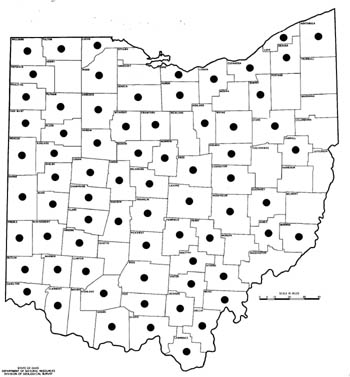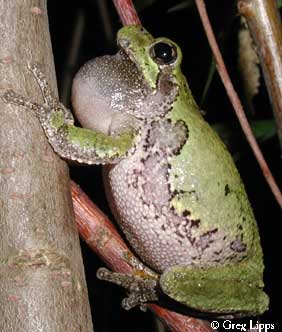Gray Treefrog and Cope's Gray Treefrog
(Hyla chrysoscelis and Hyla versicolor)
 |
 |
|
|
Distribution of the Gray Treefrogs in Ohio.
|
An adult male Gray Treefrog with vocal sac inflated.
|
|
| These species are identical in appearance, but Cope's Gray Treefrog has twice the number of chromosomes than the Gray Treefrog. Red blood cells of the Gray Treefrog are larger than those of Cope’s Gray Treefrog. | ||
Species Description: Snout-vent length 3 to 5 cm (1 1/4 to inches). Skin is warty to granular. Gray ground color is typical of both species but they may change to green. Back is marked with an irregular lichen-like pattern and the undersides are white. A white patch occurs under the eyes. Inside of each thigh has a bright yellow flash mark visible when the legs are outstretched. Toe discs are large and distinctive. |
||
Habitat: Forests and woodlots are inhabited. These treefrogs are most frequently associated with swamp forests, but they may be found in trees far from water. |
||
|
|
||
Reproductive Activity: These species can be distinguished by their advertisement calls. Chorusing begins in late April and continues through late July. The call of both species is a loud trill, one to three seconds in duration. The Gray Treefrog’s trill rate is slower and more melodious than that of Cope’s Gray Treefrog. Below 16oC (60oF) the trill rates are slowed and it becomes difficult to identify each species reliably. Eggs are deposited as small floating spherical masses. Metamorphosis occurs six to eight weeks after hatching. |
||
|
|
||
Ohio Distribution: Gray Treefrogs are widespread across Ohio. Cope’s Gray Treefrogs appear to occur only in the southern third of the state. Both are occasionally heard chorusing together. |
||
|
|
||
Status: Both species are common across their respective ranges in Ohio. |
||
Last modified:
|
Ohio Amphibians · Frog and Toad Home · Frog and Toad Species · Amphibian Habitats · Frog and Toad Calling Survey |
|
